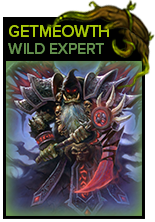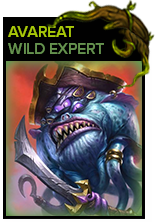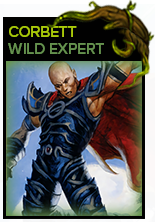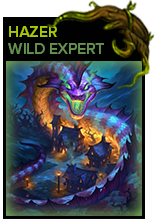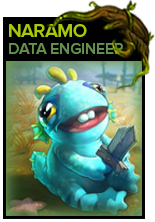
Welcome back to the Wild vS Data Reaper Report! We’re the experts from r/WildHearthstone, and we have partnered with Vicious Syndicate to create the Wild Data Reaper Report. We will be contributing the write-ups and analysis for the report, backed up by the statistics that Vicious Syndicate has become famous for. The data presented in this article is based on 60,000 games.
We want to thank everyone who has re-installed the HDT plugin after the release of the new expansion, as well as Firestone for its collaboration with vS. This has led to an increase in the pace of our data collection, allowing us to publish Wild reports faster than we ever have before.
To ensure that we can provide Wild reports as quickly as possible, we encourage you to contribute your data to the Data Reaper Project by either installing the plugin for Hearthstone Deck Tracker, or by simply using Firestone. Both methods are easy to do and your contributions are extremely important, and much appreciated!
Quick Links
Class/Archetype Distribution | Matchup Winrates | vS Power Rankings | Meta Score | Class Analysis & Decklists | How to Contribute | Credits
Class/Archetype Distribution
[TABS_PRO id=39940]
Mage is the king of the format, making up 20% of the field beyond Diamond 4. While Aluneth Mage is the most popular deck on the climb to legend, we see a slight shift within the class once people hit legend. As players gravitate towards Reno Priest, which has proven to be a very strong and well-rounded deck, other players have responded by utilizing Quest Mage as a hard counter, which is why it’s the most popular Mage deck at legend. We’ve also seen a significant rise in Reno Mages. Many of them run defensive shells alongside Luna’s Pocket Galaxy, and a few of them run Open the Waygate.
The only significant change we’ve seen in Warlock is an increase in the play rate of Mecha’thun Warlock, likely due to its great matchup against Reno Priest. The class is quite diverse, with four different archetypes seeing play.
Reno Priest has become the most popular deck in the format, with Big Priest continuing to see modest play. In the previous Data Reaper Report, we’ve noted Reno Priest’s excellent performance against nearly every archetype in the current meta except for very fast combo decks. This has certainly encouraged players to attempt to target the deck with either a natural hard counter, or certain card choices.
Despite being nerfed, Demon Hunter maintains its strong presence in Wild, with Odd Demon Hunter representing most decks within the class. Aggro Demon Hunter has not seen the same kind of success it enjoys in Standard.
After spending many reports at the bottom of the Wild meta, Warrior has finally made its breakthrough, with Pirate Warrior catching on and vaulting the class into the spotlight. Corsair Cache has made a huge impact on the archetype’s consistency in the early game, and this has resulted in the deck becoming a popular choice for those looking to climb ladder efficiently.
Paladin has significantly diversified as a class recently. Its most noticeable archetypes are Mech Paladin and Murloc Paladin, but we also see experimentation with Libram Paladin decks after the buff to Aldor Attendant (Pure and Horsemen/Control). We preach about the power and consistency of Odd Paladin in literally every report, but the player base isn’t enthusiastic about giving it a go.
Shaman’s presence in the format is modest, but it’s undergoing a dramatic change. For the first time in what seems like forever, Even Shaman is not the most popular archetype within the class. Big Shaman has emerged following the balance changes and has slowly grown in popularity since.
Druid has declined after failing to live up to its hype, with Jade and Aviana Druid remaining the class’ most recognizable archetypes. Reno Hunter is seeing a bit more play and looks like a fleshed-out archetype these days, something that the class has been missing. Rogue continues to be a complete mess, with none of its archetypes gaining traction or making any kind of impact on the meta.
[TABS_PRO id=39941]

[TABS_PRO id=39943]
vS Meta Score
[TABS_PRO id=39944]
Pirate Warrior is back, dominating Wild again, baby. The consistency and resources that Ancharrr provides, combined with explosive plays through Ship’s Cannon, has contributed to the high-power level of the deck. Now that it’s the best deck in the format, it will be interesting to see how the meta responds to it, and how it handles being the deck to beat. Should weapon tech become highly prevalent, we might see Pirate Warrior hedge for an additional weapon, or even run Hoard Pillager.
Coming in just behind Pirate Warrior are Even Shaman and Odd Demon Hunter. While not seeing much play, Even Shaman is a very strong deck in the current meta with only Reno Priest proving to be a significantly unfavorable matchup. Odd Demon Hunter is feeling the effects of the third round of nerfs, but it still sits comfortably in Tier 1, a testament to how strong the deck has been prior to the balance changes.
After arriving at the Wild scene just a few weeks ago, Big Shaman sits in a surprisingly dominant Tier 1 spot. While the deck struggles against the format staple of Reno Priest, its impressive matchups into the plethora of aggressive strategies are a strength that cannot be underestimated. With Big Shaman seemingly coming out of nowhere, we do wonder what kind of hidden gems could also be lurking, waiting to be discovered.
Aluneth Mage and Reno Priest make up the rest of the top tier, which shouldn’t be surprising to anyone. Aluneth Mage has been good for a very long time. Reno Priest might be the most well-rounded deck in the format, with excellent matchups into nearly every kind of deck out there. Dodge the auto-losses that are Quest Mage and Mecha’thun Warlock and Reno Priest will deliver.
Once again, Odd Paladin is quietly sitting at Tier 1 despite its very low play rate. The archetype has repeatedly proven its strength in the format without much fanfare. Mech and Murloc Paladin remain at Tier 2, completing a trifecta of respectable tribal decks for the class. Paladin is likely underrepresented in the current meta because there are stronger and more enticing aggressive strategies available.
Cube Warlock and Disco Warlock are the best performing decks within their class. Discard Warlock seems to have the staying power needed to remain a competitive deck in the format. Cube Warlock has slightly weakened, primarily due to the rise in Reno Priest, a very poor matchup for the deck.
Quest Mage remains in Tier 2 at legend, but once again falls to a negative win rate at the Diamond 4-1 bracket, where the meta is particularly aggressive. Quest Mage’s weakness to several aggressive decks, including the dominant Pirate Warrior that smacks it like no other, is holding it back.
Tier 3 is where we either find fringe archetypes with significant flaws, or unrefined archetypes that carry greater potential. Reno Galaxy Mage is the standout when it comes to potential: the archetype is very likely stronger than it looks but is littered with suspect builds that drag its aggregated win rate down. We think it just needs to clean up.
Class Analysis & Decklists
Demon Hunter | Druid | Hunter | Mage | Paladin | Priest | Rogue | Shaman | Warlock | Warrior
Despite being repeatedly nerfed, Odd Demon Hunter refuses to relinquish its grip on the Wild meta. The archetype is still one of the top performing on ladder, and remains the most popular deck on the climb to legend from Diamond 4. Although many players opted to cut Crimson Sigil Runner after the changes, the card is likely deserving of a spot in the deck. Priestess of Fury, on the other hand, is at more of a tipping point. The reduction in health from 7 to 5 has made her much easier to remove. Priestess can still be strong against many slower decks, such as Reno Priest, but it doesn’t look quite good enough to be an inclusion.
Odd Demon Hunter doesn’t have many counters, although it seems a new one may have appeared. Prior to the balance changes, Even Shaman was a deck that Odd Demon Hunter was handling quite easily. However, that has changed after the recent patch. Pirate Warrior is another deck that can give problems to Odd Demon Hunter, and a large reason why many players have begun to include Glacial Shard and Frozen Shadoweaver. Both are flexible minions that also shine in the Odd Demon Hunter mirror.
Aggro Demon Hunter is beginning to feel the effects of both repeated nerfs and a more refined meta. The deck struggles against nearly every one of the most popular and strongest archetypes, only doing decently against the passive and fragile opponents.
Druid is currently one of the least common classes in the format. We estimate that Jade Druid sits at Tier 3, due to an underwhelming matchup spread. It often gets outpaced by aggressive decks such as Pirate Warrior and Odd Demon Hunter, and it struggles to deal with the late game onslaught of powerhouses such as Cube Warlock and Reno Priest.
Aviana Druid continues to be played and experimented with thanks to Juicy Psychmelon, which allows you to tutor your entire win condition through one card. Both Malygos and Togwaggle variants of this archetype exist, built on a nearly identical shell. Recent variants of Aviana Malygos Druid have included Sathrovarr, which has been the cause of some hype due to the potential to OTK your opponent as quickly as turn 5 thanks to Biology Project and Overgrowth.
Reno Hunter is the only Hunter deck that sees enough play to evaluate in the current meta, and with unfavorable matchups against some of the most popular decks, it finds itself In Tier 3.
The archetype doesn’t do anything particularly powerful beyond its use of the highlander payoff cards, but other classes, such as Mage and Priest, have access to these payoffs while possessing stronger shells and synergies. Reno Hunter isn’t as terrible a deck as some of the common memes you meet on ladder, but it’s a bit mediocre.
Aluneth Mage is still an excellent deck, but one that is beginning to show signs of weakness. Between Diamond 4 and 1, it has fallen just outside Tier 1 for the first time in a year. This small dip can be attributed to an increase in the meta’s hostility. Reno Priest has risen in popularity and presents a difficult matchup, while other decks that Aluneth Mage excels against, have declined. The archetype has also lost its edge against decks that were refined to become more efficient, such as Pirate Warrior.
Given the stagnation of Aluneth Mage’s build, as well as the lack of attention it’s getting from many top players, it will be interesting to see whether the deck can find any meaningful scope for improvement.
Quest Mage is the most polarizing deck in the format. It dominates slower strategies such as Reno Priest and Mecha’thun Warlock, while exhibiting laughably poor matchups into the Pirate Warriors and Odd Demon Hunters of the world. Unfortunately for Quest Mage, Wild is currently tilted towards aggressive decks. This results in Quest Mage grading out as a reasonable, but not too consistent option for ladder, especially on the climb to legend. Builds are largely settled, with only some minor changes.
Reno-Galaxy Mage is one of the decks with the most scope for improvement and refinement. The archetype is completely polluted by spell-heavy, dragon-heavy, defensive lists, which are particularly popular at lower ranks and perform poorly. On the other hand, we’ve seen that there are minion-heavy variants that have been doing quite well, refined by a few players in the lead up to the HCTS Wild tournament.
These lists opt to run minimal spells and very little dragon-synergy. Instead, the priority is to counter-pressure opponents. This approach is quite common at top legend but has yet to trickle down to lower ranks. The featured build is one card off the list piloted by Hijo to rank 1 legend and those used by Corbett and Hijo in the tournament previously mentioned.
Reno-Quest Mage has seen a sharp decline in play, despite continuing to display a respectable win rate. The deck is a less polarizing version of Quest Mage, with a slower win condition that makes it less effective against decks that Quest Mage naturally counters, but with a greater ability to handle aggression. Dragons continue to be the default choice within the archetype.
Mech Paladin has incredible early-game blowout potential with Galvanizer and Mechwarper paired with Smuggler’s run and Grimestreet Outfitter. When it has time to set up its game plan, it’s extremely dangerous. However, it struggles against highly aggressive decks that fight for the board early, since they force Paladin to fall behind. Once behind, Mech Paladin doesn’t excel at catching back up. This places it at Tier 2.
Murloc Paladin currently has two viable versions, with or without Tip The Scales. For this report, we feature the version without it. Murloc Paladin has great early game potential with Vilefin Inquisitor and other 1-mana Murlocs. A turn one Imprisoned Sungill will activate on turn three, allowing for a Coldlight Seer to establish a strong board that threatens a Felfin Navigator or Gentle Megasaur follow up. By curving out murlocs and continuously buffing them, Murloc Paladin can be hard to deal with for passive decks that don’t challenge the board early.
Odd Paladin has been around since Baku was first introduced. The ability to summon two 1/1 recruits for 2 mana is always strong, especially with cards such as Quartermaster, Faceless Corruptor and Fungalmancer that can leverage them into immediate pressure. We estimate that Odd Paladin is a Tier 1 deck in the current meta, and it might be the best available counter to Odd Demon Hunter.
Recent buffs to Aldor Attendant and Libram of Justice have encouraged players to experiment with different shells of Pure Paladin or other kinds of Libram Paladins. These experiments are still relatively new, so we can’t properly evaluate them until they gain traction and become more popular.
Reno Priest is one of the most dominant decks in the format when you consider both its high play rate and high win rate. Its matchup spread is extremely consistent save for a couple of narrow hard counters that happen to be relatively inconsistent decks.
A dragon package gives the deck a way to withstand aggression, while Raza the Chained and Shadowreaper Anduin combine for one of the best late game win conditions in the format. When you add the other highlander payoffs, Reno Priest ends up having very few weaknesses. Only the fastest and most uninteractive combo decks can consistently beat it.
Big Priest is a completely different story, sitting at the very bottom of the Power Rankings. The deck is very unreliable, and very slow at what it does, since only the 6-mana Shadow Essence allows you to cheat out your big threats. Big Priest is so weak and underwhelming that it should just disappear, and yet there is still a significant portion of the player base that insists on playing it. Just wait until they find out about Big Shaman!
In a class that lacks an established deck, Odd Rogue is the most competitive one available, and we estimate it hovers around Tier 2. It excels at taking board control with its upgraded weapon hero power, strong class 1-drops in Spymistress and Buccaneer, and big mid-game swings thanks to Faceless Corruptor, Fungalmancer, and Vilespine Slayer. The reason why Odd Rogue isn’t very popular is likely due to the existence of a very similar, and superior deck in Odd Demon Hunter.
Galakrond Rogue in Wild has some OTK potential with Spectral Pillagers synergizing with the cost reduction enabled by Galakrond the Nightmare and Heistbaron Toggwaggle. But, this deck struggles in the early game, and gets rolled over by aggressive powerhouses such as Pirate Warrior and Odd Demon Hunter. Its win condition isn’t fast enough for most of the established combo decks in the format too.
Thief Rogue can be a fun deck to play in if you like janky randomness since every game can be different and new. However, the inefficiency of random value is just not a winning ingredient in Wild. Spectral Cutlass provides you with important survivability in aggressive matchups, but if Pirate Warrior is heavily targeted with weapon tech, Thief Rogue suffers from collateral damage.
Even Shaman continues to win Hearthstone games. It is one of the strongest decks you can take to ladder, with few poor matchups and a highly settled build centered around the totem-synergies of Splitting Axe, Totemic Might, and Totemic Surge. Regarding novel card choices, players have yet to widely adopt The Lurker Below. We would suggest they try it, as The Lurker Below was already on the fringes of being a worthwhile inclusion prior to its change, and the extra two health is a huge boost.
Now, if we were to list a Meta Breaker for this report, it would have to be Big Shaman! The archetype has truly emerged out of nowhere. The most striking thing about this development is that the deck was just waiting to be discovered, with its success largely independent of any card changes. Big Shaman was first popularized by mao221111, who took the deck to rank 5 legend prior to the buff to Torrent.
As the name suggests, Big Shaman is centered on cheating huge minions into play via Ancestor’s Call, Muckmorpher, and Eureka. Big Shaman has few weaknesses. It runs into issues against silence or transform effects, which are mostly common in Reno Priest. It’s strong against aggressive decks, while still posing serious issues for many slower archetypes due to the pressure it can apply with large minions. If nothing else, Big Shaman is a reminder that the Wild format is very unexplored compared to Standard, and that there is always a chance for new, highly competitive decks to be found.
Cube Warlock has fallen from Tier 1, primarily since Reno Priest has gotten even more popular. Reno Priest was never a great matchup for Cube Warlock, but it’s gotten even worse since many lists have cut Doomguards entirely to make it a stronger anti-aggro deck. This means that Cube Warlock misses a way to heavily pressure the Priest, who gets more time to execute its game plan. Meanwhile, Odd Demon Hunter is a very popular aggressive deck that can bypass the massive walls of taunts created by the Warlock thanks to Consume Magic, which is an obscenely strong card in Wild.
Disco (Discard) Warlock has survived the test of time, showing that it’s not a flash in the pan. While nearly unbeatable with the right draw, the deck tends to lose to two things: conceding the board or losing to itself with poor discard and draw RNG.
Mecha’thun Warlock looks to prey on slower archetypes that give it room to breathe such as Reno Priest, Cube Warlock and Jade Druid. It struggles against common aggressive strategies, which is why it finds itself in Tier 3. The new Mecha’thun Warlock (after the nerf to Bloodbloom) is also much more susceptible to disruption, but if you can high roll a turn 6 Hemet, the deck can beat anything, anytime, anywhere.
Reno Warlock has a milder case of the Big Priest Syndrome, where it’s played by a portion of faithful followers, but struggles to do anything better than other Warlock or Reno decks in the format. Reno Jackson offers a strong anti-aggro win condition that a deck like Cube Warlock doesn’t have, but it doesn’t possess the same consistency when it comes to its late game plan. It exhibits a variety of win conditions to consider, with Gul’dan and N’Zoth accompanied by the value engines of Brann, Zola, Kazakus, Barista and the disruption cards of Dirty Rat and Gnomeferatu.
An attempt to change its passive identity has emerged, with a few players experimenting with the old-school combo of Leeroy, Power Overwhelming, and Faceless Manipulator for 20 burst damage.
Ramses’ Felhound Discard Warlock
The last balance patch was bittersweet for Warrior. On one hand, all deck variety within the class disappeared, leaving Pirate Warrior as the only flagship for the class. On the other hand, Pirate Warrior has become the strongest deck in the format after Odd Demon Hunter lost some of its power.
Pirate Warrior has cemented itself as the deck to beat. This aggressive deck is backed by consistency of Corsair Cache and Ancharrr, with the weapon providing a massive draw engine that can get continuously upgraded. When Pirate Warrior gets an explosive start going, it can feel unstoppable, though Shamans and Priests look capable of picking it apart.
Players are beginning to experiment with builds that use more weapons beyond the single Ancharrr, encouraged by the increased amount of weapon removal meant to target the deck. It isn’t entirely clear which additional weapon should be played, and players have been testing two approaches. Wrenchcalibur is particularly strong at shutting down highlander-synergy cards, while Liveware Lance is stronger in faster matchups, which tend to be more prevalent.
Corbett’s Lance Pirate Warrior
Preparing our weekly article requires a significant amount of time and effort from many individuals. We would like to wholeheartedly thank our current Patreons, whose generous donations help us fund computing and server costs.
vS Gold is a new membership plan aimed to support our efforts towards improving our content and data analysis while receiving some bonuses and extra features.
Contributors
Here are all the people that participated in bringing you this edition of the [Wild] vS Data Reaper Report:
















